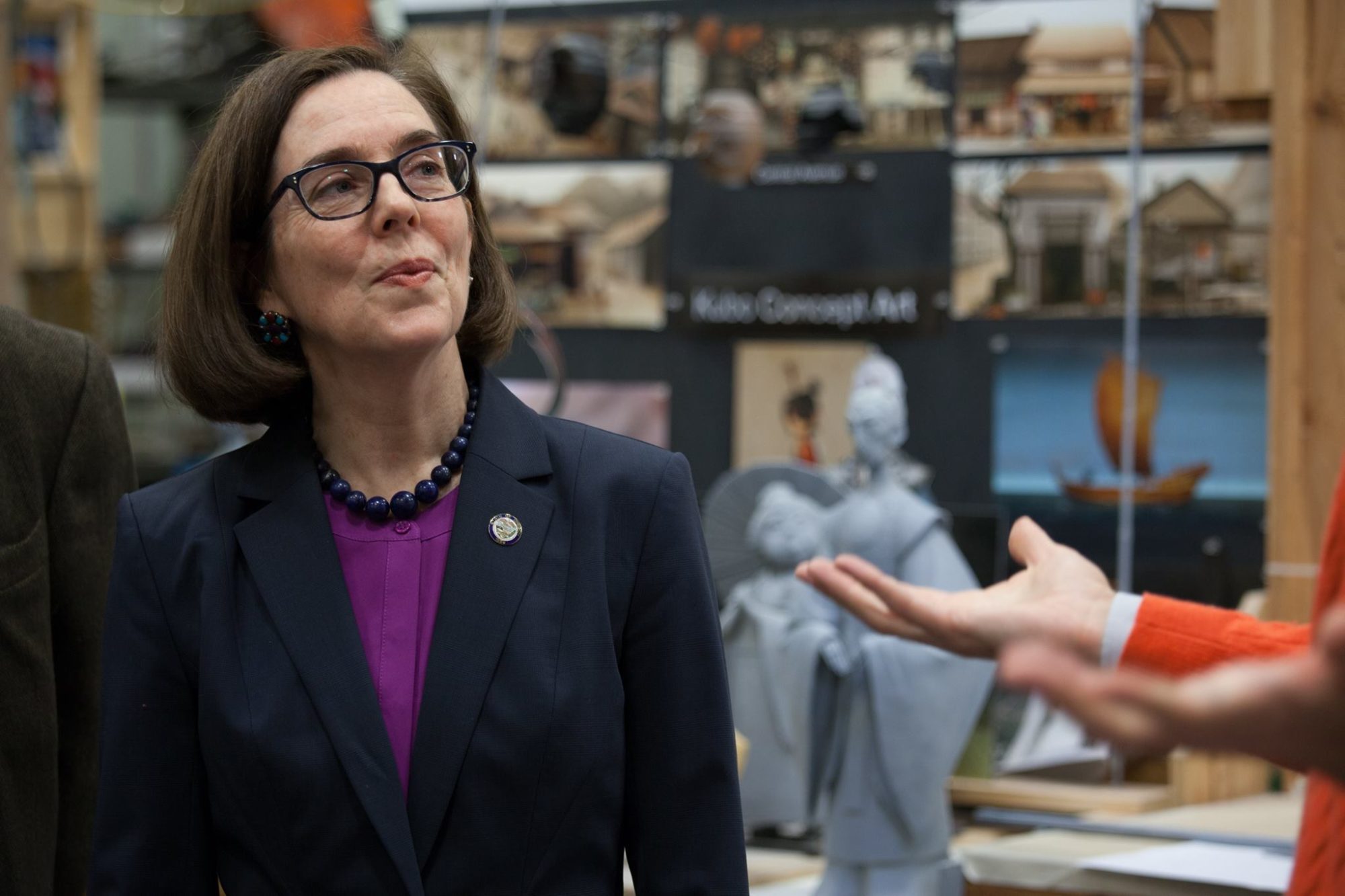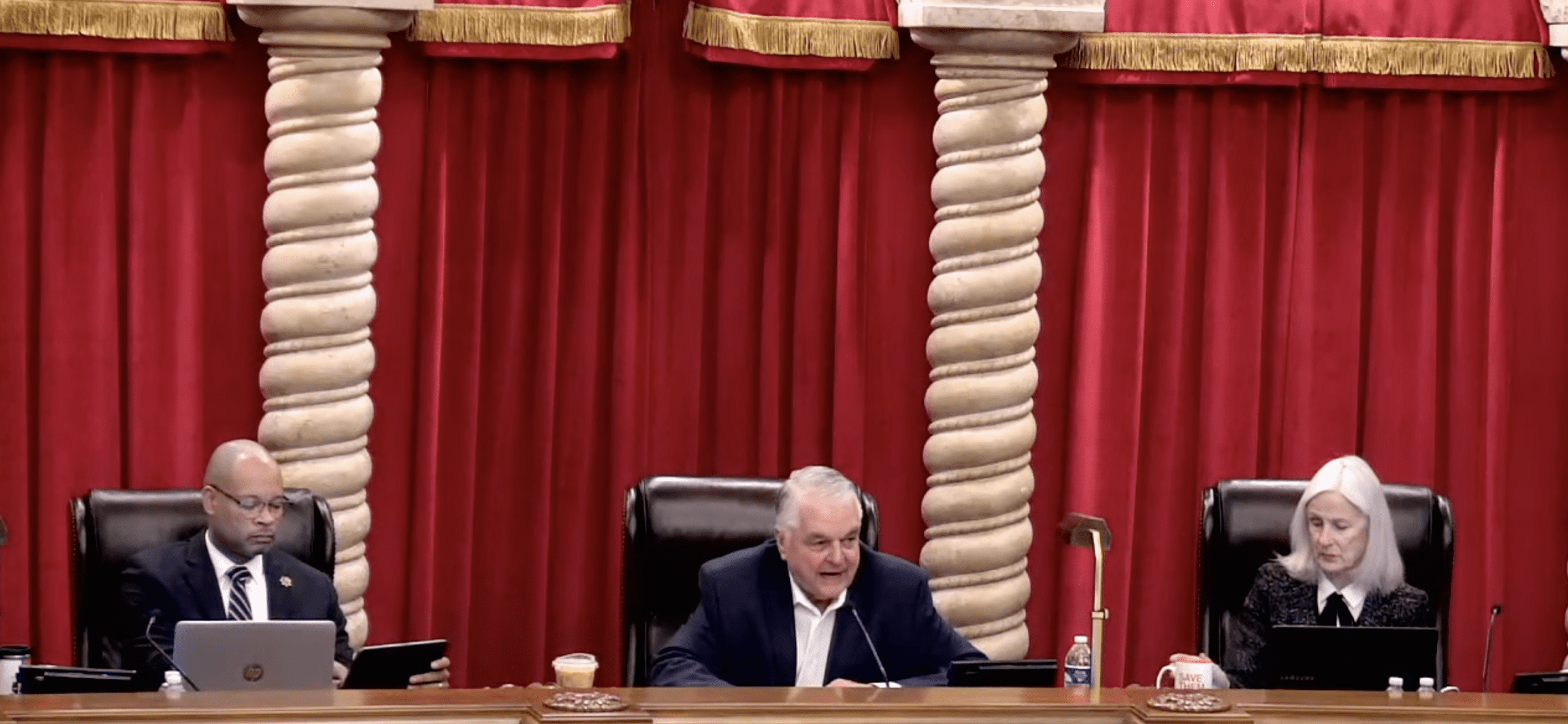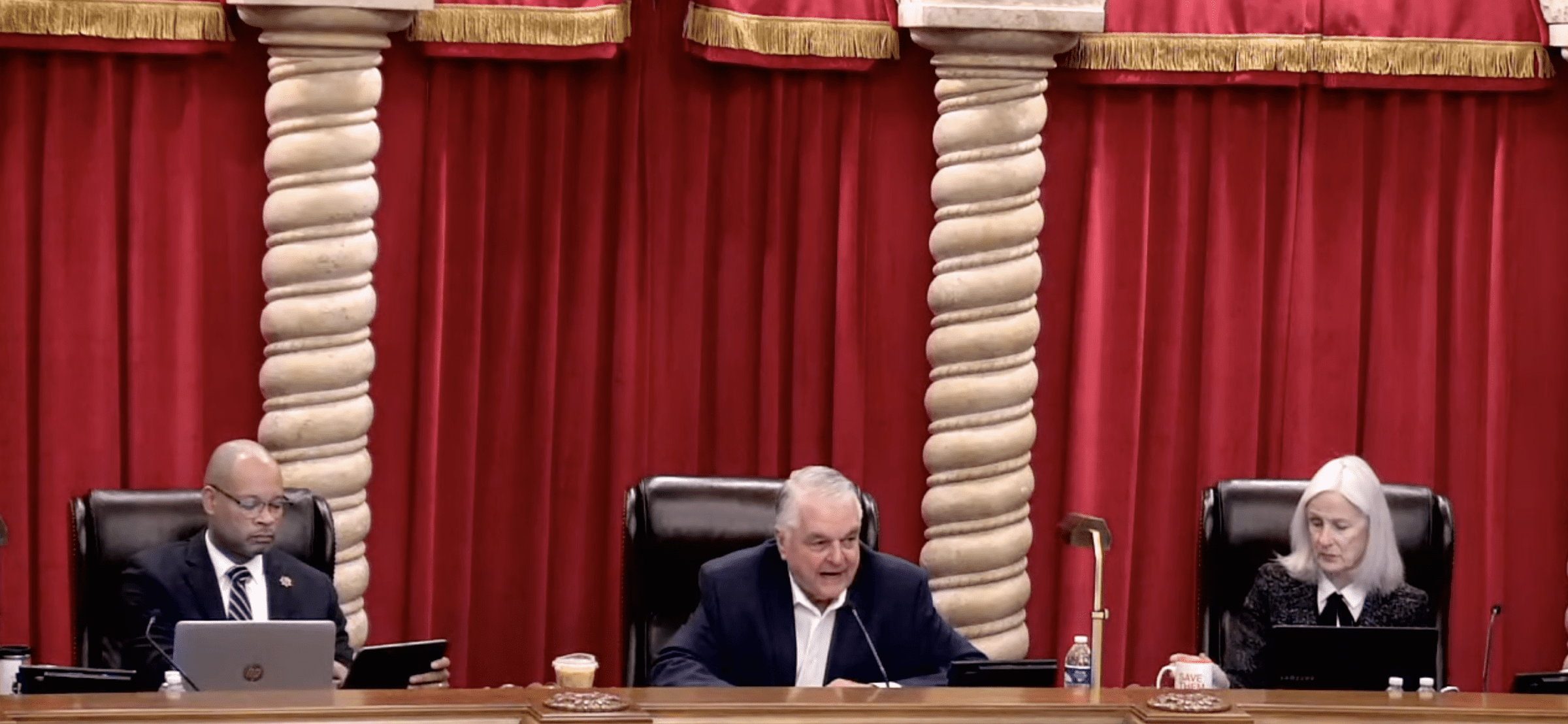Landmark Push for Clemency in Oregon and Nevada Show Split Paths on Death Penalty
Oregon’s Democratic governor emptied death row and Nevada’s tried, even as some red states try to ramp up their killing. But partisan divides on capital punishment remain complex.
Chris Geidner | December 20, 2022


When Oregon Governor Kate Brown announced last week that she was commuting the death sentences of everyone on her state’s death row to life in prison without the possibility of parole, it was a landmark moment for the use of clemency in America.
Her decision was the largest gubernatorial act of commuting people’s death sentences since 2003. Seventeen people who began the week under a sentence of death no longer face the prospect of the state killing them.
“It’s certainly unacceptable to me that I would leave office without taking one final action to ensure that none of these individuals will be executed by the state,” Brown told NPR. Brown had, even before this step, established a legacy for her “historic use” of her clemency powers.
Over the years since the U.S. Supreme Court reauthorized the use of capital punishment in 1976 after a brief moratorium, only a handful of governors have taken similarly sweeping steps—most notably, Illinois Governor George Ryan, a Republican who in 2003 commuted the sentences of the 167 people on death row there.
Brown’s mass clemency comes at a time where new death sentences and executions are at low levels nationwide. As the Death Penalty Information Center wrote in its year-end report, released this week, 2022 was the “[e]ighth consecutive year with fewer than 30 executions and 50 new death sentences.” There are 2,400 people on the nation’s death rows today, however, with blue California and red Florida leading the way.
But her actions also highlighted the stark partisan divide on the death penalty today, with two Americas drifting apart in their leaders’ willingness to carry out or block executions.
On the day Brown granted her clemency, Mississippi was preparing for the final execution in the United States this year. The state executed Thomas Loden Jr. on Wednesday, despite ongoing litigation against its lethal injection protocol. In all, 18 people were executed in the country this year, with Texas and Oklahoma carrying out five executions each. Arizona carried out three executions, Missouri and Alabama two each, and the final one in Mississippi.
All six states that carried out executions this year are currently led by Republican governors.
Democratic executives have largely blocked executions. No sitting Democratic governor has overseen one; the last to do so was Virginia’s then-Governor Terry McAuliffe, who oversaw what became the state’s final execution, of William Morva, in 2017. McAuliffe later announced his opposition to the death penalty, and Democrats abolished it in 2021 shortly after taking control of the state government. In 2020, Governor Jared Polis, a Democrat, commuted the sentences of the three people on Colorado’s death row while signing a bill abolishing the death penalty.
With Brown’s latest act of clemency, there are now 24 states that have no one on death row.
That number came close to inching up to 25 on Tuesday. At the urging of Nevada’s Democratic Governor Steve Sisolak, the state’s Board of Pardons was set to consider a motion at its quarterly meeting to commute the death sentences of everyone on Nevada’s death row.
But Carson City Judge Jim Wilson on Monday blocked that item from the meeting’s agenda, ruling that the state had not given enough notice to victims’ families. Sisolak is set to be replaced in January by Republican Joe Lombardo, a sheriff who pledged to “reverse Sisolak’s soft-on-crime policies.”
Sisolak acknowledged during Tuesday’s board meeting that there would be no vote on his proposal. “Placing this matter on the agenda was done as an act of grace, and with the understanding that the death penalty is fundamentally broken,” he said. “The administration of the death penalty is not fair and not equitable and cannot be corrected.”
District attorneys had rushed to ask courts to stop the commutations after Sisolak’s proposal. Wilson, the judge, is himself a former DA in Elko County. Nevada prosecutors have a lot of clout: Last year, state Democrats failed to repeal the death penalty despite running the legislature after a bill derailed in the state Senate, where multiple Democratic leaders have day jobs as prosecutors in Clark County, where the DA’s office is prone to seeking death sentences. Sisolak’s comments at the time also helped stall the bill.
“The fact that prosecutors in Nevada once again took steps to ensure the government is able to execute people is of little surprise since they continue to use the threat of execution as a means of coercion in criminal prosecutions,” Athar Haseebullah, the executive director of the ACLU of Nevada, told Bolts.
“I am glad the governor made this most recent push for commutations, but the last four years provided Nevada leaders, including the vaunted Democratic trifecta, multiple opportunities to address this issue and we walk away on this issue four years later in the same predicament we were in four years ago,” Haseebullahhe added.
The partisan divide is similarly complex in other states.
Some Republican governors have been far more aggressive than others in carrying out executions. And Democratic Party leaders have also been split on how much they should do to bring capital punishment to an end. And major tests loom in 2023 for Democratic officials—in Arizona, as well as in the White House.
Brown’s announcement in Oregon could put more pressure on her Democratic peers, starting with President Joe Biden.
Biden campaigned on a promise to “eliminate the death penalty” and Attorney General Merrick Garland put a moratorium on executions in 2021. But Garland’s Justice Department is continuing to support ongoing capital cases and his administration on Dec. 15 cast a vote against a United Nations resolution calling for a global death penalty moratorium. In a memorandum explaining its vote, the United States Mission to the United Nations stated, in part, that “the U.S. does not understand the lawful use of this form of punishment as contravening respect for human rights.”
Of particular importance on the federal level is the fate of the more than 40 people on federal death row now. Former president Donald Trump launched an execution spree after more than 15 years of no federal executions, ultimately resulting in 13 federal executions under his watch. Since Biden took office, many opponents of the death penalty have urged him to use his clemency power to commute sentences and prevent a later president from carrying out a similar spree. Thus far, Biden has taken no action.
The failure of the Nevada Board of Pardons to commute death sentences before the end of Sisolak’s term leaves the door open to executions since Nevada has 57 people on death row. Nevada has not executed anyone since 2006, but prosecutors this year tried to secure an execution date before a supply of lethal drugs expired.


Apart from the federal government and Nevada, the other jurisdictions with people on death row and Democratic executives at this time are California, Kentucky, Kansas, Louisiana, North Carolina, and Pennsylvania. None have held an execution in over a decade, many much longer.
In California and Pennsylvania, Democratic governors have imposed moratoriums but have not pushed for mass clemency. Governor Gavin Newsom retained his office last month in California; in Pennsylvania, Governor Tom Wolf, who set up the moratorium in 2015, will soon be replaced by Governor-Elect Josh Shapiro, the outgoing attorney general. Shapiro, who had a mixed record with criminal justice progressives as attorney general, said this year that he agreed with Wolf’s approach and that he would not sign a death warrant while governor.
But an incoming Democratic governor will soon be under scrutiny in Arizona, a state that carried out multiple executions last year, and test the party’s consistency in blocking executions.
In November, Katie Hobbs became the first Democrat since 2006 to win the gubernatorial race and she already faces decisions—including her appointment to a vacancy on the state’s Board of Executive Clemency, a body that must recommend clemency to the governor—that will shape Arizona’s criminal justice future.
A Hobbs spokesperson did not respond to questions about her plans for addressing the death penalty and executions in her state.
Arizona’s outlook is complicated by the fact that it is not yet clear whether Hobbs will be working with a Democrat or Republican attorney general come January. The November race was so close—Democrat Kris Mayes led by 510 votes in the initial tally—that an automatic recount is underway. Outgoing Attorney General Mark Brnovich, a Republican, fought in court to restart executions in Arizona after a several-years halt following the botched execution of Joseph Wood in 2014. The state executed three people in 2022, and Brnovich has asked the Arizona Supreme Court to set an execution date for Aaron Gunches.
Oklahoma stands out among the states led by Republicans. Recently re-elected Governor Kevin Stitt is on a killing spree, the state set 25 executions over a two and a half year period, through the end of 2024, although two of the planned executions (Richard Glossip and John Hanson) have already not gone ahead.
Earlier this year, Stitt pressured the chair of Oklahoma’s pardon board to resign due to his support for clemency petitions. The board had repeatedly urged Stitt to commute the death sentence of Julius Jones, a man who had maintained that he was innocent for decades; Stitt did eventually agree, breaking with Attorney General John O’Connor, a Stitt appointee who has supported his execution spree and clashed with the board in pushing for Jones’s execution.
O’Connor, however, lost his re-election bid in the Republican primary this year to Gentner Drummond, who ran as what The Oklahoman described “an attorney general who would be independent of the governor’s office,” and the approach that Drummond will strike on capital punishment-related issues is a big question heading into 2023.
Texas, like Oklahoma, continued apace with five executions, lower than it has in past years (except for 2020 and 2021, when the pandemic even led Texas to halt executions for some time), but still the most in the nation this year. The state largely re-elected its leaders last month.
For all his bluster in fighting prosecutors who oppose the death penalty, Florida Governor Ron DeSantis, with the second largest death row in the country behind California, has not carried out an execution since his first year in office, when he oversaw two executions. But the supreme court that he reshaped has made it considerably harder to challenge death sentences.
Botched executions and ongoing litigation over the availability of lethal drugs stalled the death penalty in a number of GOP-led states. DPIC dubbed 2022 “The Year of the Botched Execution,” finding seven of the 20 execution attempts were visibly problematic as a result of executioner incompetence, failures to follow protocols, or defects in the protocols themselves.
Ohio Governor Mike DeWine is going to finish his first term in office having not carried out a single execution despite more than 100 people facing death sentences in Ohio. The governor has issued multiple reprieves as pharmaceutical companies continue to refuse to sell lethal drugs. In Tennessee, similarly, after questions arose about the state’s preparation of execution drugs for a scheduled execution in April, Governor Bill Lee issued a reprieve to stop that day’s scheduled execution. Soon thereafter, he went further and orderied a review of the state’s execution process and a halt to executions for the year.
In Alabama, however, Governor Kay Ivey chose to stay with the more aggressive group of governors — until there was, effectively, no other option than a pause. After one horribly botched, three-hour ordeal in executing Joe Nathan James Jr., the state proceeded to attempt two other executions that were both halted before lethal drugs were administered. Only then, on Nov. 21, did Ivey order a “top-to-bottom review” of the state’s clearly failing execution process and request that no execution dates be set during the review.
The news out of Oregon didn’t change the state’s day-to-day reality: Oregon had not carried out an execution in 25 years. Still, opponents of capital punishment celebrated Brown’s commutations as a critical move, stressing that a future governor who supports the death penalty could have lifted the moratorium on executions currently in effect in the state.
“Our state still has the death penalty. Two out of three candidates for governor in last month’s election were committed to resuming executions,” Bobbin Singh, executive director of the Oregon Justice Resource Center, told Bolts. “While the winner, Tina Kotek, said she would continue the moratorium, it’s a reminder there’s no guarantee that Oregon will be free of executions while we have people under death sentences.”
Despite Brown’s clemency, the state retains the death penalty on the books. State Democrats passed a law in 2019 that very significantly restricted its use, but repealing it altogether would demand a constitutional amendment and referendum. (Oregonians last voted on the death penalty, inscribing it in the state constitution, in 1984.)
“Voters would have to overturn it at the ballot,” Singh said, “but we shouldn’t underestimate how influential Brown’s leadership will be in moving us toward abolition.”
Sign up and stay up-to-date
Support us
Bolts is a non-profit newsroom that relies on donations, and it takes resources to produce this work. If you appreciate our value, become a monthly donor or make a contribution.


